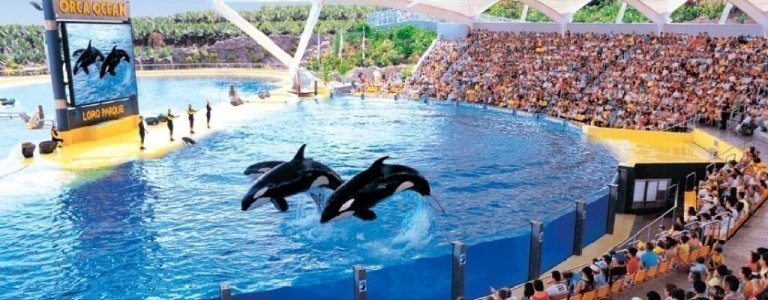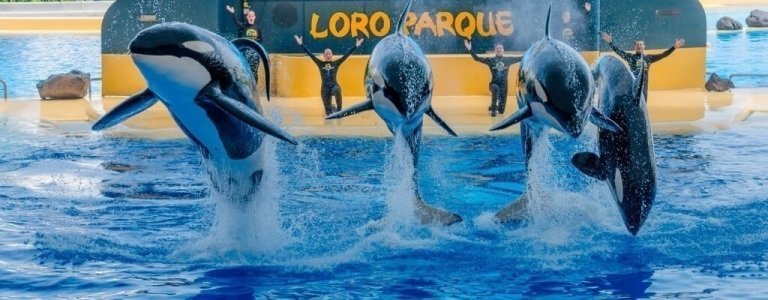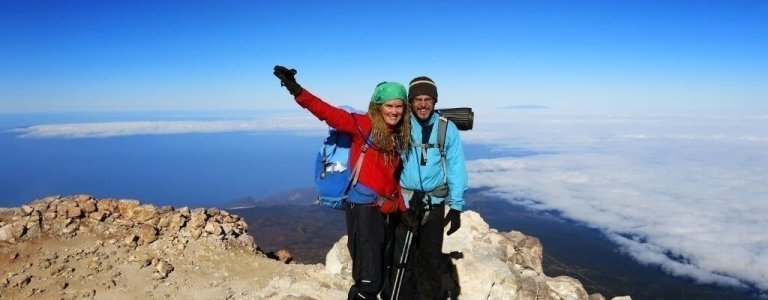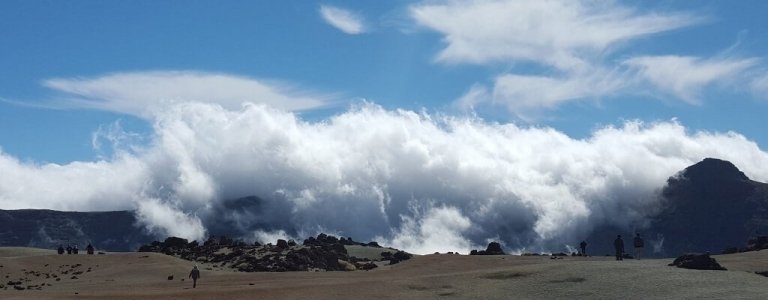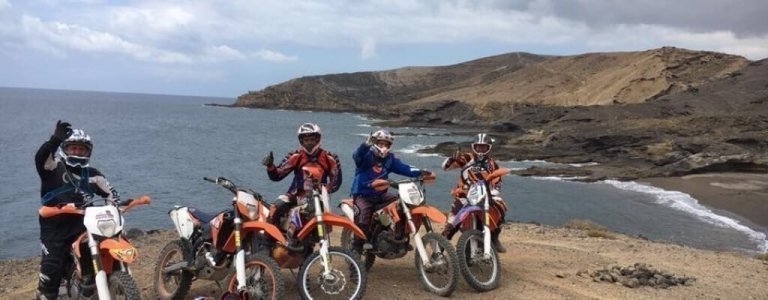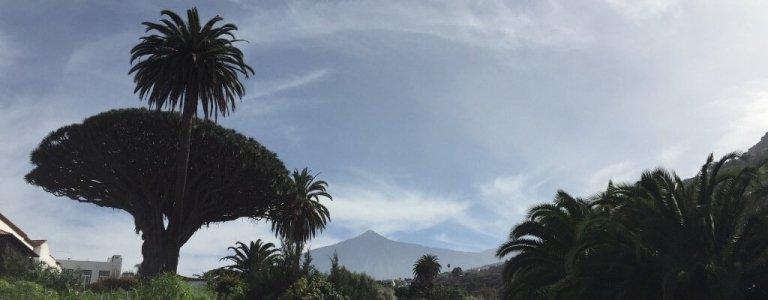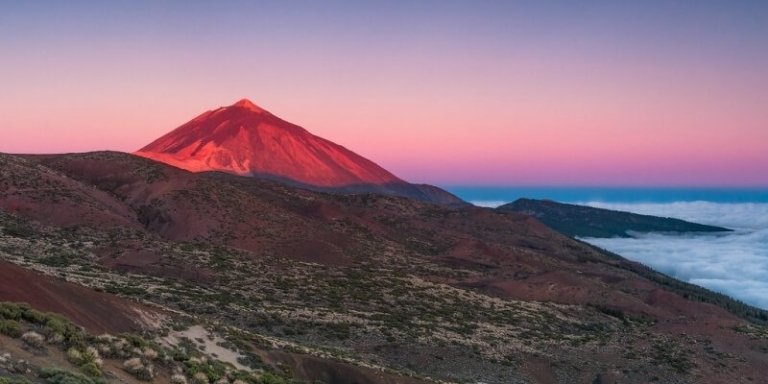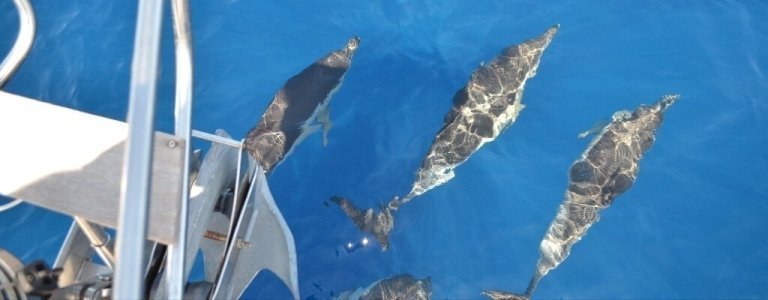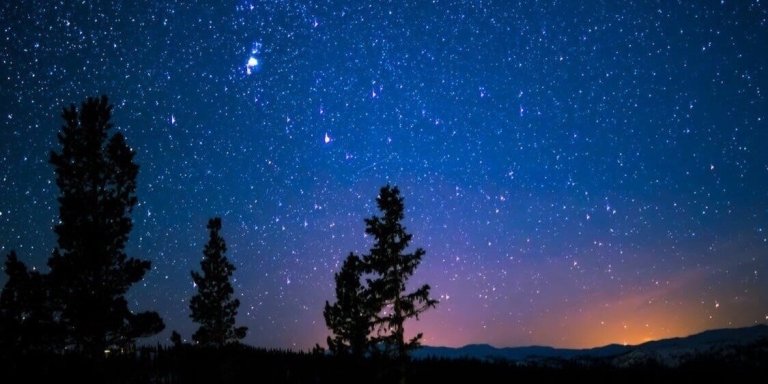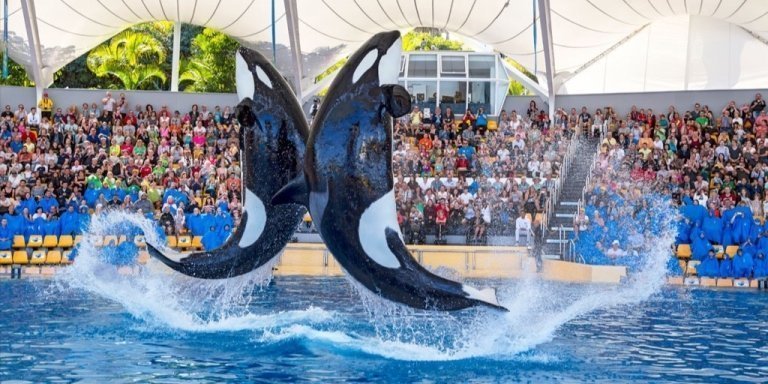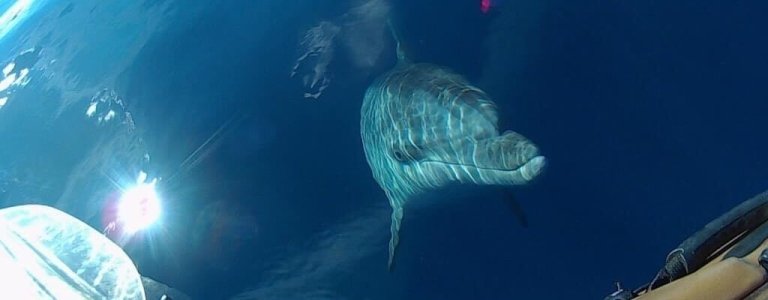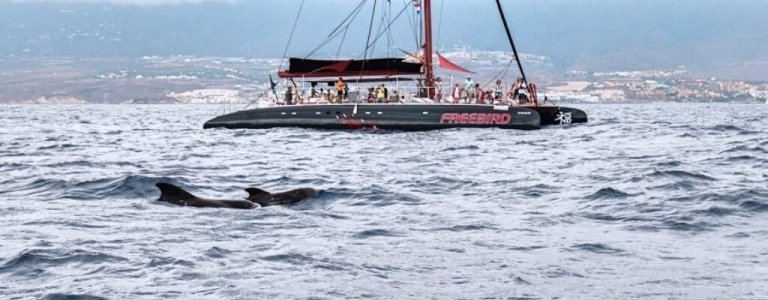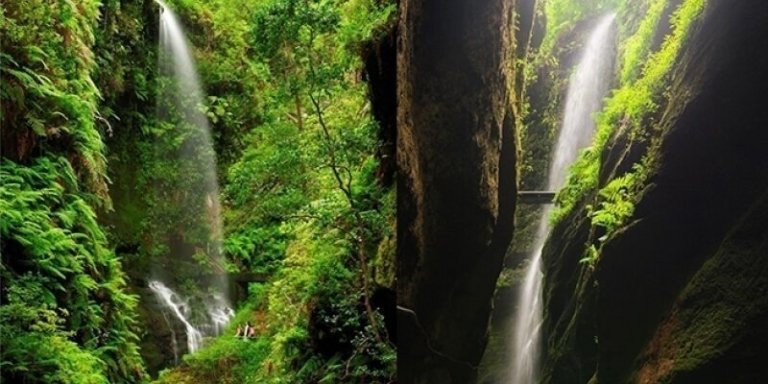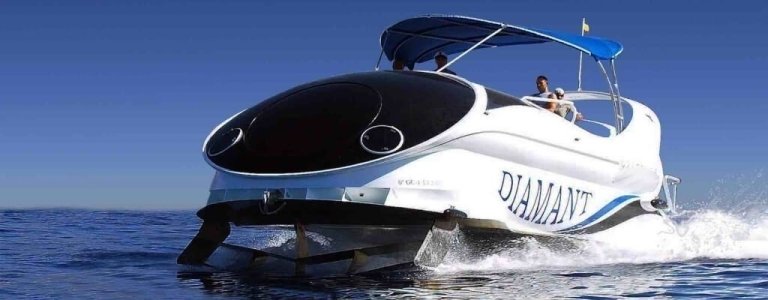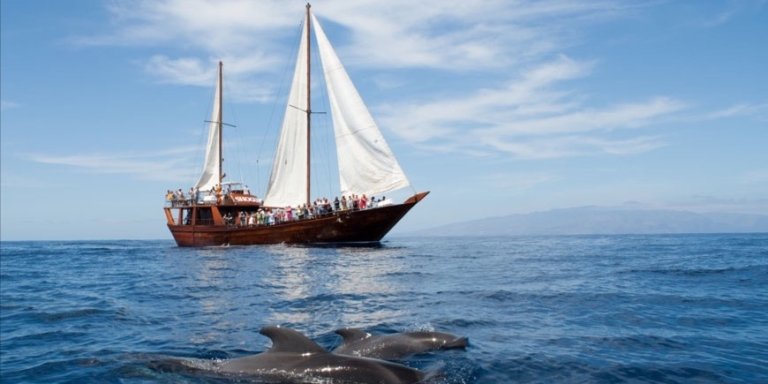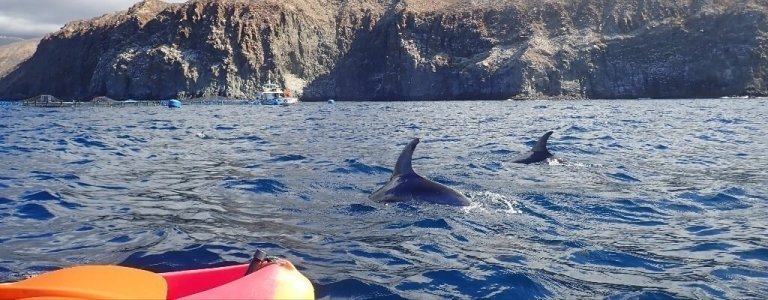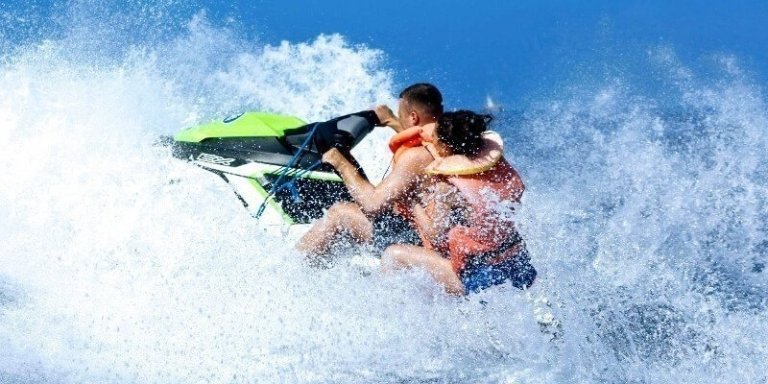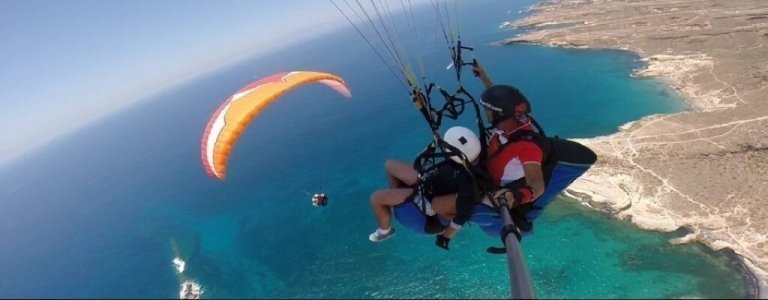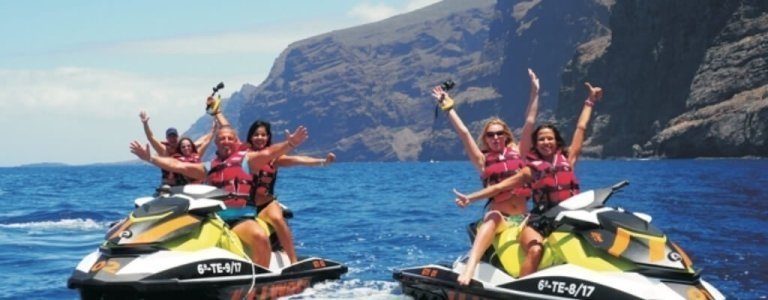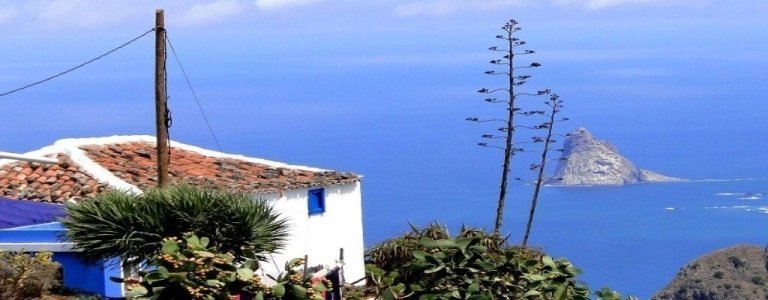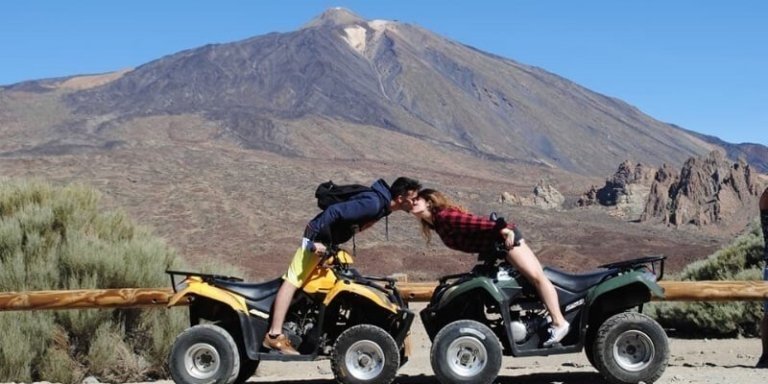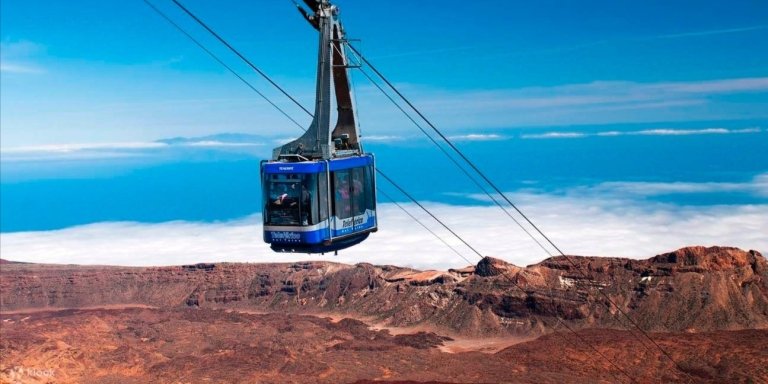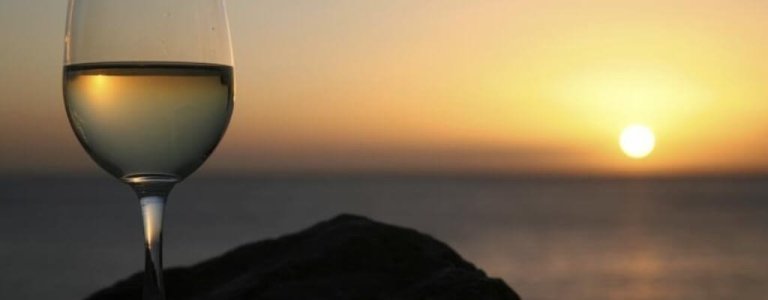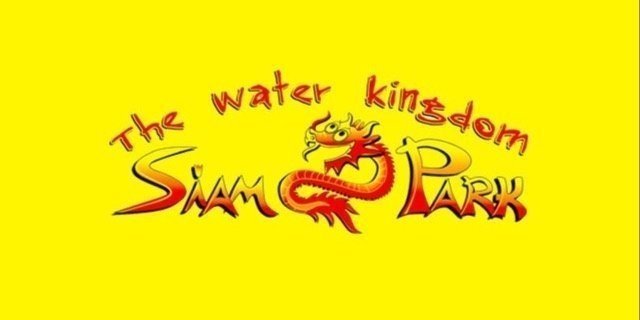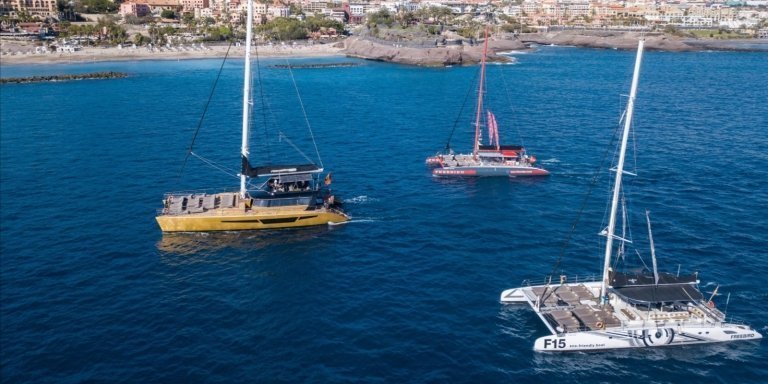Frequently Asked Questions
What are some popular Tenerife tours?
Tenerife offers an extensive selection of popular tours and excursions designed to cater to a diverse range of interests and preferences. Here are five of the most sought-after Tenerife tours, suitable for nearly every type of traveler:
Loro Parque and Siam Park Combo - enjoy a thrilling adventure that includes visits to Loro Parque and Siam Park. This tour provides express bus transfers to Loro Parque, a renowned zoo and botanical garden, as well as admission to Siam Park, one of Europe's top water parks.
Tenerife Island Tour - immerse yourself in the beauty of Tenerife with a comprehensive island tour. This excursion takes you to iconic destinations such as Teide, Masca, Garachico, and the impressive El Drago tree.
Tenerife North Tour from the South - embark on a journey to the northern part of Tenerife, exploring Anaga Junge, Anaga Rural Park, and the UNESCO-listed city of La Laguna. This tour offers insights into the island's lush landscapes and rich culture.
Freebird Catamaran Dolphin and Whale Watching - set sail on the Freebird Catamaran for an unforgettable dolphin and whale watching experience. Encounter these magnificent marine creatures in their natural habitat while enjoying the sea breeze and stunning views.
La Gomera Island Tour from Tenerife - venture beyond Tenerife and explore the neighboring Canary Island of La Gomera. Discover the natural wonders of Garajonay National Park and take in the island's breathtaking scenery.
With approximately 200 Tenerife tours to choose from, the ideal excursion depends on various factors, including your age, preferences, fitness level, and budget.
We recommend exploring all available Tenerife tours to select those that align with your specific interests and requirements. Your Tenerife adventure awaits!
Are there any guided tours in Tenerife?
Tenerife offers an extensive array of guided tours designed to help visitors uncover the diverse attractions and experiences the island has to offer. These guided tours are led by expert local guides who bring history, culture, and intriguing insights to life during your exploration of Tenerife.
Here's a glimpse of the guided tour options available on the island:
- Sightseeing, Historical and Cultural Tours - embark on journeys through Tenerife's captivating history and culture with guided tours of historic cities like La Laguna, Santa Cruz, and Garachico. Delve into the island's colonial past, architectural marvels, and significant landmarks.
- Nature and Adventure Tours - immerse yourself in the natural wonders of Tenerife through guided nature hikes, and visits to pristine national parks such as Teide National Park and Anaga Rural Park. Knowledgeable guides enrich your understanding of the island's unique ecosystems.
- Wine and Gastronomy Tours - Tenerife's reputation for vineyards and wine production shines through in guided wine tours. Explore local wineries, gain insights into the art of winemaking, and savor tastings of the island's renowned wines. Sample authentic Canarian dishes, savor the island's rich gastronomic culture.
- Water Activities - dive into Tenerife's underwater realm with guided snorkeling, scuba diving, and kayaking tours. Expert guides accompany you, enhancing your exploration of Tenerife's marine wonders.
- Stargazing Tours - Tenerife's crystal-clear night skies create an ideal setting for stargazing. Join guided astronomy tours or visits to the Teide Observatory for unforgettable celestial observations.
- Boat and Catamaran Tours - set sail on guided boat tours along the picturesque coastlines for dolphin and whale watching experiences, as well as exhilarating snorkeling adventures.
- Volcano Tours - unearth the volcanic landscapes of Tenerife with guided volcano tours. Venture to Mount Teide and its surroundings while absorbing insights into the island's geological history.
- Adventure Tours - thrill-seekers can choose from a range of guided adventure tours that offer adrenaline-pumping activities such as paragliding, canyoning, motor sports and off-road excursions.
- Private Tours - tailor your Tenerife adventure with private guided tours provided by select tour operators. Customize your itinerary for a personalized and exclusive experience.
Tenerife's guided tours are designed to accommodate diverse interests and activity levels, ensuring that every visitor can maximize their time on the island while benefiting from the expertise of local guides.
Tell me about Tenerife day trips available?
Tenerife offers a wide variety of day trips that allow visitors to explore the island's diverse landscapes, attractions, and experiences in a single day. Whether you're interested in natural beauty, cultural heritage, adventure, or relaxation, there's a day trip in Tenerife to suit your preferences.
We suggest to use on this page tour category filters to explore all available Tenerife day trips since TripsPoint offers hundreds of experiences in Tenerife.
What are the top-rated excursions in Tenerife?
The Top-10 rated excursions in Tenerife are the following:
Experience the pinnacle of luxury with the Teide Private VIP excursion. This exclusive tour allows you to explore the iconic Mount Teide and its surroundings in style. Enjoy personalized attention as you discover the natural wonders of Tenerife's highest peak. With this excursion, you'll have the privilege of a private guide and an unforgettable journey.
Delve into the lush and captivating landscapes of Tenerife's Anaga Mountains with the Anaga Mountains & Jungle Private Tour. This intimate excursion offers a personalized adventure through the island's oldest and most mystical forest. Explore hidden trails, encounter unique flora and fauna, and uncover the secrets of the Anaga jungle with a private guide.
For a comprehensive exploration of Tenerife's diverse beauty, opt for the Private Tour Around the Island. This excursion allows you to discover the island's contrasting landscapes, from volcanic craters to picturesque coastal villages. Your private guide will tailor the tour to your interests, ensuring an unforgettable journey filled with breathtaking sights.
Experience the magic of Loro Parque, one of Tenerife's most renowned attractions, with the Loro Parque Excursion. Departing from the southern part of the island, this excursion takes you to a world-class zoo and botanical garden where you can marvel at exotic animals and lush tropical landscapes. Tickets and transfers included.
Embark on a challenging yet rewarding adventure with the Private Hiking Tour to the Mt. Teide Summit. This excursion grants you exclusive access to hike to the summit of Mount Teide, an active volcano and Spain's highest peak. With permits included, you'll conquer this iconic mountain while enjoying the expertise of a mountain private guide.
Rev up your adrenaline with the Off-Road Enduro Tenerife Motorcycle Tour. This thrilling excursion is perfect for motorcycle enthusiasts seeking an off-road adventure. Navigate rugged terrain, conquer obstacles, and explore Tenerife's natural beauty on two wheels.
Set sail on the Freebird Catamaran for an unforgettable Whale Watching Excursion. Cruise along the crystal-clear waters of Tenerife's coastline and witness majestic marine life, including dolphins and whales, in their natural habitat. It's a wildlife experience that promises breathtaking encounters.
Indulge in privacy and relaxation aboard the Arriro Sailing Yacht Private Charter. This excursion offers an exclusive sailing experience along Tenerife's coastline. Bask in the tropical sun, take in the stunning views, and savor the tranquility of the sea during your private yacht charter.
Discover the wonders of the night sky with the Tenerife Stargazing Excursion. This unique tour combines astronomy, wine tasting, and tapas for a magical evening. Join expert astronomer to observe celestial marvels while enjoying local wines and delicious tapas under the stars.
Explore the highlights of Tenerife with the Tenerife Island Bus Excursion. This comprehensive tour takes you on a comfortable bus journey to the island's top attractions, from historic cities to natural wonders. Ideal for travelers seeking a relaxed and informative way to discover Tenerife's diverse landscapes and culture.
Each of these top-rated Tenerife excursions offers a distinct and memorable experience, catering to a variety of interests and preferences. Whether you're seeking adventure, relaxation, or cultural immersion, Tenerife has an excursion to fulfill your desires.
Where can I find information about Tenerife trips?
You can easily access information about Tenerife trips on the TripsPoint website by following these straightforward steps:
- Visit the TripsPoint Website. Start your journey by opening your web browser and entering "www.tripspoint.com" in the address bar.
- Search for Tenerife Trips. To discover an array of Tenerife trip options, utilize the website's search function. Enter keyword "Tenerife" into the search bar located at the top of the page and choose 'Tenerife' from the list.
- Explore Tenerife Trip Options. As you conduct your search, you'll be presented with a selection of Tenerife trip choices. Each option will feature a concise description and a link that allows you to access more detailed information.
- View Trip Details. If a Tenerife trip captures your interest, click on it to access comprehensive information about the excursion. This will furnish you with a thorough overview of the trip, including its itinerary, inclusions, pricing, and available dates.
- Book Your Tenerife Trip. When you decide to embark on a Tenerife adventure, you can make your reservation directly through the TripsPoint website. Simply follow the straightforward booking instructions provided on the trip's page.
- Peruse Reviews. TripsPoint often incorporates reviews and ratings from fellow travelers who have previously participated in the same excursion. Perusing these reviews can offer valuable insights into the experiences of past participants.
- Reach Out to the excursion provider or Support. Should you have specific inquiries or require assistance with booking your Tenerife trip, don't hesitate to contact tour provider by clicking "Ask a Question" on the tour page or contact TripsPoint support team.
Remember to incorporate relevant keywords like "Tenerife" or "Costa Adeje", etc when conducting your search on the TripsPoint website. Doing so will ensure that you find the precise information you seek. TripsPoint serves as an invaluable resource for planning and securing your Tenerife adventures.
Can you recommend any Tenerife sightseeing tours?
Absolutely, we have some fantastic recommendations for Tenerife sightseeing tours that cater to various budgets. Tenerife offers an array of sightseeing tours that allow you to explore the island's beauty and culture. Whether you're looking for budget-friendly options or willing to invest in a premium experience, we've got you covered.
Budget-Friendly Tenerife Sightseeing Tours from the South of the island:
Tenerife Island Tour by Coach - this is a must-do Tenerife sightseeing tour that provides a comprehensive overview of the island's top attractions. Ideal for those staying in the southern part of Tenerife.
Santa Cruz, La Laguna, and Anaga Bus Sightseeing Tour - explore the vibrant cities of Santa Cruz and La Laguna, along with the scenic Anaga region. This tour offers great value for travelers in the southern part of the island.
Budget-Friendly Tenerife Sightseeing Tours from the North of the island:
Tenerife Island Tour by Bus from the North - if you're based in Puerto de La Cruz in northern Tenerife, consider this sightseeing tour. It covers the island's key highlights, providing an enriching experience.
Anaga & Two Capitals Bus Sightseeing Tour - delve into the charm of northern Tenerife with this budget-friendly tour. Explore picturesque landscapes and cultural gems.
Premium Tenerife Sightseeing Tours for a Comprehensive Experience:
Teide National Park Private VIP Tour - for those seeking a top-tier experience, this private VIP tour of Teide National Park is a perfect choice. Enjoy personalized attention and explore the iconic park at your own pace.
Tenerife Private Tour Around the Island - immerse yourself in the beauty of Tenerife with this premium private tour that covers the entire island. This day adventure allows you to discover the island's diverse landscapes and cultural treasures.
If you book a private tour there's no matter where are you going to stay in Tenerife - the tour guide will pick you up from your location.
Whether you're budget-conscious or looking for a deluxe experience, these Tenerife sightseeing tours offer a range of options to suit your preferences. Explore the wonders of Tenerife and create lasting memories on your journey.
Are there Tenerife party boat excursions?
Absolutely, TripsPoint offers a Tenerife Party Boat Excursion, promising an unforgettable aquatic adventure for those seeking a lively and entertaining experience. The vibrant boat outings typically unfold against the backdrop of Tenerife's stunning coastline and come packed with an array of activities and entertainment options.
Can I see the stars from Teide Observatory?
Tenerife visitors often inquire about the possibility of utilizing the Teide Observatory's telescopes for stargazing. It's crucial to recognize that the Teide Observatory primarily serves as a scientific institution devoted to astronomical research and observations. Below are the key explanations why tourists typically do not have access to the observatory's telescopes:
- Research Takes Precedence. The Teide Observatory's primary mission revolves around conducting cutting-edge scientific research in the field of astronomy. Astronomers and scholars hailing from different corners of the globe depend on the observatory's state-of-the-art telescopes and specialized instruments to scrutinize diverse celestial phenomena, spanning stars, planets, galaxies, and more. This research plays a pivotal role in advancing our comprehension of the universe.
- Restricted Accessibility. Given the paramount importance of the research carried out at the observatory, access to its telescopes is subject to stringent restrictions. Astronomers and scientists have allocated specific time slots and meticulously planned observation schedules to execute their experiments and scientific observations. These schedules are devised months or even years in advance.
- Specialized Equipment. The telescopes and scientific instruments housed at the Teide Observatory are exceptionally specialized and often necessitate technical expertise for their proper operation. They are not intended for casual or recreational stargazing by tourists.
- Light Pollution Management. The Teide Observatory is strategically located within a designated Starlight Reserve, where concerted efforts are undertaken to minimize light pollution and maintain ideal conditions for astronomical observations. Allowing unregulated access to the telescopes could potentially disrupt these meticulously preserved conditions.
- Educational Initiatives. While tourists may not engage with the observatory's telescopes for research-oriented purposes, several educational programs and guided tours are available, providing visitors with the chance to delve into the realm of astronomy. These programs facilitate night sky observation through smaller telescopes and offer valuable insights into the endeavors of astronomers and researchers.
- Stargazing Excursions. Tenerife boasts an array of stargazing excursions and activities that enable tourists to savor the island's pristine night skies. TripsPoint offers you the best of all Tenerife stargazing excursions. Through professional telescopes designed for stargazing, participants can marvel at celestial objects.
In summation, although tourists generally do not have access to the Teide Observatory's telescopes for scientific undertakings, they can still relish the celestial wonders of Tenerife. Dedicated stargazing tour present an opportunity to bask in the splendor of the cosmos while garnering profound insights into the universe. These experiences offer a tourist-friendly and illuminating environment for all enthusiasts of the night sky.
Can I see pilot whales in Tenerife?
Absolutely sure, you can spot pilot whales in Tenerife's pristine waters. Tenerife's coastal areas are home to a variety of marine life, and among them, the short-finned pilot whale (Globicephala macrorhynchus) is a prominent resident. Here's why you should consider taking excursions in Tenerife to observe these remarkable creatures:
- Pilot Whale Sightings - pilot whales, with their distinctive features like a bulbous forehead and sleek body, are frequently seen in the waters surrounding Tenerife. They are known for their social behavior and often travel in tight-knit family groups, which makes them captivating to observe in their natural environment.
- Whale-Watching Tours - numerous tour operators on TripsPoint offer specialized whale-watching excursions in Tenerife designed to give you a chance to witness pilot whales and other cetacean species, including bottlenose dolphins. These tours come with experienced guides who can offer valuable insights into the behavior and biology of these marine mammals.
- Stunning Coastal Locations - Tenerife's southwestern coast, particularly around areas like Los Gigantes and Adeje, is renowned for its consistent pilot whale sightings. The chances of encountering these magnificent animals are favorable throughout the year, establishing Tenerife as a prime destination for wildlife enthusiasts and nature admirers. Important to understand that your chances to see pilot whales are practically guaranteed if you start your excursion in the morning around 10:00 am and much lower after 3:00 pm.
When planning your Tenerife excursions, consider adding a whale-watching tour to your itinerary to witness the awe-inspiring pilot whales in their natural habitat. It's an unforgettable experience that allows you to connect with the island's rich marine biodiversity.
What are the top snorkeling spots in Tenerife?
Palm-Mar and El Puertito stand out as premier snorkeling destinations in Tenerife, thanks to their pristine, translucent waters, rich marine biodiversity, and convenient accessibility.
These sites offer snorkelers unparalleled underwater visibility, granting them the privilege of encountering a vibrant array of marine species, including colorful fish, graceful sea turtles, and elusive octopuses.
Notably, these areas have succeeded in maintaining flourishing marine ecosystems, drawing snorkeling enthusiasts of all proficiency levels. Furthermore, the diverse range of snorkeling sites found within Palm-Mar and El Puertito ensures that a snorkeling excursion there is a unique and captivating adventure. Whether you're a novice or an experienced snorkeler, the combination of natural beauty and ease of access makes Palm-Mar and El Puertito the top choices for a snorkeling excursion in Tenerife.
What are the best Tenerife travel tips for tourists?
Hola! Here are some of out Tenerife travel tips for tourists visiting the island:
- Plan Your Excursions - Tenerife offers a wide range of excursions and activities and almost all of them you can book at TripsPoint. Plan your excursions in advance to ensure you don't miss out on popular tours like Teide National Park or whale watching.
- Book Online in Advance - many excursions in Tenerife must be booked online in advance. This not only saves you time but also ensures availability, especially during peak tourist seasons.
- Pack Sun Protection - Tenerife enjoys abundant sunshine. Pack sunscreen, sunglasses, and a wide-brimmed hat to protect yourself from the sun's rays.
- Stay Hydrated - the warm climate can lead to dehydration, so carry a reusable water bottle and drink plenty of fluids, especially if you're outdoors.
- Comfortable Footwear - if you plan to explore the island's natural beauty, bring comfortable walking shoes or hiking boots. Tenerife offers fantastic hiking opportunities.
- Cash and Cards - while credit cards are widely accepted, having some cash on hand is useful for small purchases and in case you visit places with limited card payment options.
- Respect the Environment - Tenerife's natural beauty is its treasure. Please respect the environment by not littering, staying on designated paths, and following any conservation guidelines.
- Try Local Cuisine - don't miss the chance to savor Canarian cuisine. Taste dishes like "papas arrugadas" (wrinkled potatoes) and "mojo" sauce. Explore local markets and restaurants for authentic flavors.
- Learn Basic Spanish - while many locals speak English, learning a few basic Spanish phrases can enhance your experience and show respect for the local culture.
- Beach Etiquette - if you're spending time on Tenerife's beautiful beaches, follow beach etiquette by cleaning up after yourself and using designated facilities.
- Reserve Accommodations - book your accommodations well in advance, especially if you're traveling during the high season. Tenerife offers a variety of lodging options, from luxury resorts to budget-friendly hostels and airbnb's.
- Emergency Information - familiarize yourself with local emergency numbers and the location of the nearest embassy or consulate in case you need assistance.
- Experience Local Traditions - Tenerife celebrates various festivals and traditions. If you have the opportunity, join in the festivities and experience the local culture.
- Travel Insurance - consider purchasing travel insurance that covers medical emergencies, trip cancellations, and unforeseen circumstances.
- Have a Flexible Itinerary - while planning is essential, leave room in your itinerary for spontaneity. Tenerife has hidden gems waiting to be discovered.
By following these Tenerife travel tips, you can make the most of your visit to this enchanting island, ensuring a memorable and enjoyable experience.
How big is Tenerife?
Tenerife, the largest of the Canary Islands. it is around 2,034 square kilometers. That is approximately 785 square miles.
To give a perspective, it's roughly the size of the US state of Rhode Island!
Its majestic landscapes range from volcanic terrains to verdant forests and beautiful beaches. A unique mix of scenery on one island.
How old is Tenerife?
Tenerife's age is traced back to its volcanic origins. It's around 3-5 million years old.
Lastly formed just about 200 000 years ago.
The island's most notable geological feature is Mount Teide. The highest peak in Spain. And it is estimated to be around 3 million years old.
The cultural history of the island, from the original Guanche inhabitants to its current population, is also rich and diverse.
How many airports in Tenerife?
Tenerife is served by two airports:.
- Tenerife North Airport (TFN). Also known as Los Rodeos.
- Tenerife South Airport (TFS). Known as Reina Sofia.
Tenerife South Airport is the larger and busier of the two. It has a large number of international flights.
How many people live in Tenerife?
As of the latest statistics, Tenerife is home to approximately 978 000 residents. Plus about 250 000 tourists constantly rotating.
This population is quite diverse. Locals known as "Tinerfeños" .
A significant number of expats and migrants from around the world. It's giving the island a rich, multicultural vibe.
How do you get to Tenerife, Spain?
Getting to Tenerife, Spain, involves air travel. From most major cities in Europe, you can find direct flights to Tenerife's two airports. There are numerous connecting flights through Spanish mainland cities like Madrid or Barcelona. It's also possible to come with a car by ferry from Cadiz. If you're already in the Canary Islands, you can also reach Tenerife by ferry. Or by aeroplane by Binter. Local Canary airlines connecting islands.
What are the best Tenerife excursions?
Tenerife offers a wide range of exciting excursions and activities to suit various interests. Here are some of the best Tenerife excursions:
- Teide National Park. A visit to Mount Teide, Spain's highest peak, is a must. You can take a cable car to the summit for breathtaking views. Or explore the park's unique volcanic landscapes. There are different options to visit Teide. From the cheapest with Teide bus sightseeng tour to a Teide private tour exclusively for you.
- Whale and Dolphin Watching. Tenerife's waters are home to various species of whales and dolphins. You can join Tenerife boat tours to observe these magnificent creatures in their natural habitat. One of the most popular boat trips is Arriro yacht private charter if you want to awoid crowds of people. Or Freebird Catamaran Tenerife half-day boat trip if you prefer bigger boats and amusement onboard.
- Loro Parque. This popular zoo and botanical garden is home to a diverse range of animals. Parrots, killer whales, dolphins, gorillas and more. It's a great family-friendly excursion. You can easily get there from the South of the island booking Loro Parque tickets with express bus transfer included.
- Siam Park. If you love water parks, Siam Park is one of the best in Europe. It features thrilling water slides, a lazy river, and a wave pool. You can also combine Siam Park with Loro Parque visit. Opt for the Twin Ticket offer with Loro Parque transfer included. That will cost you cheaper than booking 2 parks separately.
- Anaga Rural Park . Explore the lush forests, hiking trails, and charming villages in the Anaga Rural Park. It offers a different perspective of Tenerife's natural beauty. There are different ways to visit Anaga. With a low budget you can take Anaga sightseeing bus excursion. Or private tour of Anaga if prefer a personal gude and driver.
- Stargazing Tours. Tenerife is known for its clear skies. It's an ideal place for stargazing. You can join guided small group Tenerife stargazing excursion to observe the night sky and learn about astronomy.
- Tenerife ATV, Buggy & Motorcycle excursions. Take a Tenerife buggy excursion, Teide ATV tour or Off-Road Enduro excursion in Tenerife. Explore island's rugged interior and off-the-beaten-path locations. It's an adventurous way to see the island's diverse landscapes.
- Submarine Safaris. Interested in marine life but prefer to stay dry? Consider a submarine safari to explore the underwater world around Tenerife.
- Wine Tasting in Tenerife. Tenerife produces some excellent wines. Visit vineyard to taste local wines. Learn about the winemaking process with Tenerife wine tasting experience, one of the best excursions in Tenerife.
- Santa Cruz de Tenerife. Explore the island's capital city. Visit historical sites, enjoy local cuisine. Do some shopping in Santa Cruz taking comfortable bus transfer from the South and back.
- Tenerife Beaches. Relax on Tenerife's beautiful beaches. Such as Playa de las Teresitas or Playa del Duque, for a more laid-back excursion.
The best Tenerife excursion for you depends on your interests and preferences. Be sure to research and book in advance, especially during peak tourist seasons, to secure your spot on these popular activities.
How much do Tenerife excursions cost?
The cost of Tenerife excursions vary widely depending on the type of excursion, the duration, the provider, and the specific inclusions.
On this page at TripsPoint you can easily fit your budget using price range filter for excursions price. On mobile you can find the find the filter in the side bar and on mobile abover tour listings.
In example, you can set your Price range from 0 to 100 USD or Euros. So the system will show you only those excursions in Tenerife that are priced within your budget, so up to 100 USD or Euros.
Where can I book Tenerife excursions?
You can book Tenerife excursions from various sources. Both online and in person. But you can be for 100% sure TripsPoint booking platform is the best place to book your local experiences and excursions in Tenerife and here's why.
Following factors determine why TripsPoint.com is the best place to book Tenerife excursions:
- Reviews and Ratings. Look for reviews and ratings from travelers who have used TripsPoint.com to book Tenerife excursions. Reading about their experiences can provide additional insights into reliability and the quality of the excursions offered.
- Selection of Excursions in Tenerife. TripsPoint.com offers a wide variety of Tenerife excursions. That's to match your interests and preferences. A diverse selection allows you to choose the activities that best suit your needs. Use filters to sort excursions by category, duration or price range.
- Pricing and Value. Compare the prices of excursions on TripsPoint.com with those on other booking platforms. You will discover and ensure you're getting a competitive rate. Consider the value you'll receive for the cost, including inclusions and amenities.
- Booking Process. The ease of booking excursions through the TripsPoint.com platform. A user-friendly and secure booking process is essential for a positive experience. You have all that at TripsPoint.
- Customer Support. Our responsive and helpful customer support team is helpful. We will always assist you with any questions or issues that may arise with existing bookings.
- Cancellation and Refund Policies. Review the platform's policies regarding cancellations and refunds. It's important to understand your options in case your plans change. Cnacellation policies are differen for every single excursion. And clearly lister on each tour page at TripsPoint.
- Security and Payment Options. TripsPoint.com provides the highest level of secure payment options. It protects your personal and financial information.
- Local Partners and Guides in Tenerife. TripsPoint.com collaborates only with reputable local tour operators and guides in Tenerife. Experienced and knowledgeable guides will enhance your excursion experience.
- Additional Benefits. Our platform offers you additional benefits with TripsPoint Money.
- Flexibility and Customization. In many cases TripsPoint.com allows for customization of excursions. That's to meet your specific preferences or offer flexible booking options.
To make an informed decision, consider reading recent reviews, reaching out tour providers using "Ask a Question" option on the tour page. Or our customer support for inquiries. Compare TripsPoint.com with other booking platforms. You can be sure we align with your needs and expectations when booking Tenerife excursions.
When booking Tenerife excursions, make sure to read reviews. Compare prices, and check the cancellation and refund policies. Booking Tenerife tours in advance is highly recommended. Especially during the peak tourist season, to secure your spot on the desired excursion.
What are the top attractions for Tenerife day trips?
Tenerife is a diverse and beautiful island with a wide range of attractions for day trips. You can conduct them with group or private excursions. Here are some of the top attractions for Tenerife day trips linked to the day-tours covering an exact attraction:
- Teide National Park. This UNESCO World Heritage Site is home to Mount Teide, Spain's and whole Atlantic Ocean highest peak. You can take a cable car ride or hike to the Teide summit with permit for panoramic views of the island. Or explore the park's unique volcanic landscapes along dedicated trails.
- Masca Village. Masca is a picturesque mountain village nestled in a rugged canyon. The drive to Masca is an adventure in itself, and once there, you can explore the charming village and enjoy breathtaking scenery.
- Loro Parque. Located in Puerto de la Cruz, Loro Parque is a renowned zoo and botanical garden featuring a wide variety of animals, including parrots, dolphins, and gorillas. It's a great family-friendly destination.
- Anaga Rural Park. This lush and ancient forested area in the northeastern part of the island offers excellent hiking opportunities, including trails through ancient laurel forests and breathtaking coastal vistas.
- Siam Park. If you're looking for a fun and adventurous day, visit Siam Park, one of Europe's best water parks. It boasts thrilling water slides, a lazy river, and a wave pool.
- Garachico. This historic town on the north coast of Tenerife is known for its unique volcanic rock pools, charming streets, and historic architecture. It's a great place to explore and relax.
- Pyramids of Güímar. Visit the mysterious Pyramids of Güímar, a collection of six-step pyramids built from lava stones. The site also has an ethnographic museum. There are no regular excursions to the pyramids, so the only options are customized private tours, or take a rental car, taxi or public bus.
- Icod de los Vinos. Explore the town of Icod de los Vinos, known for its ancient Dragon Tree (El Drago Milenario) and historic old town.
- La Orotava. This town is known for its beautiful historic center, including ornate balconies and impressive churches. You can also visit the Casa de los Balcones, a historic mansion.
- Bajamar and Punta del Hidalgo. These coastal towns offer natural rock pools where you can swim and enjoy the ocean in a unique setting.
- Adeje Coast. The southern coast of Tenerife, around Adeje, offers beautiful beaches like Playa del Duque and Playa de Fanabe, as well as upscale resorts and shopping areas.
- Santa Cruz de Tenerife. Explore the island's capital city, visit historical sites, museums, and enjoy local cuisine and shopping.
Remember that the best Tenerife day trip for you will depend on your interests and the part of the island you are staying in. Most of Tenerife attractions are easily accessible from the South of the island and choice from Puerto de La Cruz or Santa Cruz is very limited. Some of these attractions may require more time to explore fully, so plan your day trips accordingly to make the most of your visit to Tenerife.
Are there any Tenerife excursions suitable for families?
Exploring Tenerife with your family is a delightful experience. Thanks to a plethora of family-friendly excursions and activities. Here's a list of top-notch Tenerife excursions that cater to families with children:
- Loro Parque. Situated in Puerto de la Cruz, Loro Parque stands as a favorite choice among families. This exceptional attraction combines a zoo and a botanical garden, showcasing a diverse range of animals. Including parrots, dolphins, sea lions, and gorillas. Kids are in for a treat with entertaining shows and enlightening presentations.
- Siam Park. Nestled in Costa Adeje, Siam Park reigns as one of Europe's premier water parks. It boasts a thrilling assortment of water slides, a leisurely lazy river, an exhilarating wave pool. Plus a specially designed children's play area known as "Siam Park Junior."
- Whale and Dolphin Watching. Embarking on a boat excursion to witness whales and dolphins in their natural habitat is a thrilling adventure that kids adore. Tenerife's waters host a variety of species. Many ou our boat tour operators offer family-centric trips.
- Teide Cable Car. A ride on the Teide Cable Car promises an exhilarating adventure for children. From the summit, the awe-inspiring views are sure to captivate young explorers as they venture through the volcanic terrain. Not suitable for children up to 3 years!
- Submarine Safaris. Tenerife presents an extraordinary opportunity for families to explore the underwater world. Without getting wet through submarine tours. This unique experience also offers valuable educational insights for kids.
- Beach Days. Tenerife boasts a plethora of family-friendly beaches with calm waters. Such as Playa de las Teresitas and Playa de Los Cristianos. It's the perfect setting for relaxation, sandcastle building, and soaking up the sun.
- Pirate Ship Adventures. For an extra dash of adventure, some tour operators provide pirate ship-themed boat excursions. With engaging entertainment for children, including treasure hunts and swashbuckling pirate shows.
- Tenerife Zoo (Monkey Park). Monkey Park offers an up-close encounter with various species of monkeys and other fascinating animals. A captivating experience for kids.
- Anaga Forest. While some trails in Anaga Rural Park may be too challenging for young children, there are also easier paths. Like the Sendero de los Sentidos. Families can explore the rich natural beauty of the area together.
- Aqualand Costa Adeje. Another exciting water park option, Aqualand Costa Adeje. It features an array of water slides, pools, and attractions designed to delight families.
- Botanical Gardens. A leisurely family stroll amidst the stunning flora and fauna awaits in Jungle Park. Or at the Botanical Gardens in Puerto de la Cruz. Or Palmetum in Santa Cruz.
- Santa Cruz de Tenerife. Explore the island's capital city. With its charming parks, lively squares, and attractions like the Museum of Nature and Man, offering educational opportunities for children.
When planning your family-friendly Tenerife excursions, consider your children's ages, interests, and activity levels.
Many our tour operators and attractions extend special rates or discounts for children. So don't forget to check out all the price options while you are booking family excursions. tMaximize your unforgettable Tenerife experience.
What are the must-visit places during Tenerife boat excursions?
Tenerife boat excursions offer an incredible opportunity to explore the island's breathtaking coastline and the enchanting waters that surround it. Here, we unveil some of the must-visit destinations and captivating highlights you can savor during your Tenerife boat adventure:
Los Gigantes Cliffs (Acantilados de Los Gigantes). These majestic cliffs grace Tenerife's western shores, presenting a truly awe-inspiring spectacle. Opt for boat tours that glide you close to these colossal formations. Immerse yourself in their towering grandeur and exquisite beauty.
Masca Bay. Nestled in proximity to the Los Gigantes Cliffs, Masca Bay is a postcard-perfect cove ensconced by dramatic cliffs. It's a coveted stop for boat excursions. Often coupled with a visit to the charming village of Masca.
La Gomera Island. Select boat tours extend the option of venturing to the neighboring island of La Gomera. Here, you can delve into its distinct landscapes, explore picturesque villages, and revel in lush vegetation.
Whale and Dolphin Watching. Tenerife's pristine waters teem with a rich variety of marine life. Including pilot whales, bottlenose dolphins, and an array of fascinating species. Many boat excursions incorporate captivating whale and dolphin watching experiences into their itineraries. It's important to remember, all the whale and dolphin watching trips starting from marinas of the Southern part of Tenerife. And not from the North.
El Puertito. Positioned on the tranquil western coast, El Puertito beckons with its serene bay. Ideal for snorkeling and swimming. Several boat tours pause here, allowing passengers to partake in a refreshing dip within the crystal-clear waters.
Turtle Spotting. Keep a keen eye out for delightful encounters with sea turtles during your boat excursion. Particularly, the areas around Palm Mar Wall and the southwestern coast . It often offer rewarding glimpses of these graceful creatures.
La Caleta. This quaint fishing village exudes charm. It is renowned for its seafood restaurants and laid-back ambiance. A number of boat tours include a visit here. It's enabling you to relish a delectable meal or explore the village's unique character.
Underwater World. Tenerife's submerged world boasts captivating volcanic formations. And an astonishing array of marine biodiversity. Submarine excursions offer opportunities and granting you a window to this mesmerizing underwater realm.
Sunset Cruises. For a touch of romance, indulge in a sunset boat excursion. You'll be treated to mesmerizing vistas of the sun setting over the vast Atlantic Ocean. These tours often include soothing music and delightful refreshments.
Local Cuisine onboard. Depending on the chosen boat tour, you may have the pleasure of savoring traditional Canarian cuisine or tapas. A delectable taste of the island's gastronomic treasures.
Specific sites and experiences encountered during your Tenerife boat excursion may vary. Depend on your tour operator and chosen package. It's prudent to peruse reviews and scrutinize the itinerary. Simply to ensure a harmonious match with your preferences. No matter if your fascination lies in marine life. Or in dramatic landscapes, or simply basking in the ocean breeze. Tenerife's boat excursions offer a diverse range of experiences tailored to your desires.
Can I go hiking on Tenerife excursions?
Explore Tenerife through excursions offers a world of adventure. For those with a passion for hiking, this captivating Canary Island transforms into a hiker's utopia. Tenerife boasts a diverse tapestry of hiking trails. Trails are perfectly tailored to accommodate varying skill levels and preferences. Are you an intrepid mountaineer seeking the exhilaration of summiting rugged peaks? Or a casual stroller yearning for coastal vistas? Tenerife's excursion options cater to all.
You can check out all actually available hiking tours. Do it by simply clicking on the "Trekking, Hiking & Riding tours" filter on this page. Or on the link to Tenerife hiking excursions that will show you all the options to choose and book.
Here's a glimpse into the hiking wonders that await for you in Tenerife:
- Teide National Park. As a UNESCO World Heritage Site. The Teide National Park beckons hikers with an array of well-marked trails that traverse its unique volcanic landscapes. You may choose the challenging ascent to Mount Teide's summit. Or opt for shorter walks within the park. This destination promises awe-inspiring adventures.
- Anaga Rural Park. Nestled in Tenerife's northeastern realm. The Anaga jungle and mountains unfurls a picturesque canvas of luxuriant forests, craggy mountains, and quaint villages. Its extensive network of hiking trails presents diverse experiences. Ranging from serene coastal ambles to demanding mountain treks.
- Masca Valley & Teno Mountains. The trek through Masca Valley stands as one of Tenerife's iconic hiking odysseys. Meandering through a dramatic canyon, replete with towering cliffs and lush greenery.This path culminates in the charming coastal village of Masca. While it poses a challenge, the scenic rewards are boundless.
- Laurel Jungle. Tenerife boasts several ancient laurel forests, known as "laurisilva" each shrouded in enchantment. Our tour providers offer short, family-friendly walks in Las Mercedes forest. As well as extend their allure through lengthier and more demanding hiking excursion in Anaga.
- Barranco del Infierno. Adeje's Barranco del Infierno (Hell's Ravine) leads hikers through a captivating canyon. It's adorned with waterfalls and crystalline pools. It is a protected natural sanctuary. The access is regulated to preserve its pristine environment.
- Montaña Roja. For those drawn to coastal rambles, Montaña Roja near El Médano provides an accessible ascent. Enjoy panoramic vistas of the coastline and its surroundings, promising a gratifying excursion.
- Cumbre Vieja. The southern precinct of Tenerife, the Cumbre Vieja, boasts an assortment of hiking trails. They unveil breathtaking panoramas. It is renowned for its volcanic topography and resplendent pine forests.
When contemplating a hiking escapade in Tenerife, be mindful of your fitness level, trail complexity. Consider prevailing weather conditions. Certain hikes like Mount Teide summit hike may necessitate permits. Or enforce daily visitor limitations to safeguard the environment, warranting preliminary arrangements.
Furthermore, ensure you equip yourself with suitable hiking gear. Stay hydrated, and adhere to safety guidelines. Foster a secure and gratifying hiking voyage on the island.
Are there Tenerife volcano tours?
Tenerife offers volcano tours. It provides visitors with the freedom to explore the island's volcanic landscapes. Including the renowned Mount Teide. It stands as Spain's and Atlantic's highest peak and remains an impressive volcano. These volcano tours offer a captivating voyage into the history of geology. Unveiling the mesmerizing landscapes sculpted by volcanic forces. Here is our selection of Tenerife's volcano tours:
Mount Teide Volcano Tour. Undoubtedly the most sought-after volcano tour in Tenerife. This expedition allows you to ascend Mount Teide summit with permit included via a cable car ride. From the summit, panoramic vistas of the island and its neighboring counterparts unfold. It's worth noting that access to the summit may require a permit. Must be secured in advance. This is guided tour enriching the experience with insights into the volcano's geological history and significance.
Teide National Park Tours. Teide National Park, bestowed with UNESCO World Heritage status, offers an array of guided tours. These excursions delve into the park's volcanic terrain, showcasing its distinctive flora and fauna. Certain tours also incorporate visits to volcanic craters and lava formations. You can visit Teide National Park complitely different ways:
- With a Teide bus tour from the South of Tenerife
- With a Teide bus tour from Puerto de La Cruz
- With Teide bus tour from El Medano and Golf del Sur area
- With Teide coach tour from Los Gigantes area
- With a Teide private VIP tour
- With a buggy tour to Teide
- With Teide quad / ATV tour
Teide Trekking and Hiking Tours. For the intrepid traveler, Tenerife presents trekking and hiking tours. They lead you through the island's volcanic landscapes. These tours cater to various fitness levels and preferences. A variety of options that span from leisurely strolls to challenging multi-day hikes. Teide light hiking excursion is a perfect option for everyone. You'll to get in touch in nature of Teide volcanic landscapes in a low budget. On the other side, the most difficult and challenging private Mt. Teide summit hiking tour. This is for those fit and in a very good physical condition.
Nighttime Teide Tours. This specialized tour grant visitors the chance to explore Mount Teide during the nighttime hours for a celestial encounter. Tenerife's renowned clear night skies provide the backdrop for stargazing experiences. Often complete with telescopes for observing stars and constellations. Go for Teide stargazing tour with a professional astronomer in a small group.
Private Volcano Tour with Sunset and Stargazing. Tailor your volcano tour experience with a private tour led by a local guide. This personalized approach allows for a customized itinerary. Align with your specific interests and preferred pace.
Teide Volcano and Wine Tour. Immerse yourself in the fusion of Tenerife's volcanic landscapes and culinary delights. These tours that combine visits to volcanic sites with wine tastings at one of local wineries. A delectable and enlightening experience.
Before embarking on a Tenerife volcano tour, it is prudent to verify availability. Also review the itinerary, and ascertain any specific prerequisites. Such as permits for ascending Mount Teide. Are a fervent geology enthusiast? Or simply intrigued by Tenerife's volcanic legacy? These tours promise a distinctive and educational expedition on the captivating island of Tenerife.
What are the best Tenerife excursions for wildlife and nature enthusiasts?
Tenerife beckons as a paradise for wildlife and nature enthusiasts. It's boasting an abundance of unique ecosystems and captivating species. Do your heart beats for the great outdoors and the thrill encounters? Tenerife offers unique excursions and activities to satiate your passion:
- Whale and Dolphin Watching. Venture into Tenerife's azure waters. There's a mesmerizing world of marine life unfolds. Witness pilot whales, bottlenose dolphins. Array of other aquatic marvels in their natural habitat. Numerous boat tour operators at TripsPoint curate catchy whale and dolphin watching excursions. And offering you the privilege of observing these majestic beings up close.
- Teide National Park. Embark on a journey into the UNESCO World Heritage-listed Teide National Park. A realm ruled by the awe-inspiring Mount Teide volcano. Traverse well-trodden hiking trails. Or opt for guided hiking tour that immerse you in the singular flora and fauna that thrive amidst this volcanic landscape.
- Anaga Peninsula. Located in Tenerife's northeast, the Anaga Rural Park presents a verdant haven adorned with ancient forests and rugged trails. For the ardent nature enthusiast, this is a sanctuary. A place to encounter Tenerife's native laurel forests and a diverse tapestry of birdlife. The best way to visit Anaga is to take Anaga private tour with a local tour guide. It will take you to the hidden gems where cannot get with any other tours.
- Birdwatching. Tenerife occupies a pivotal position for migratory birds. It's a treasure trove for avid birdwatchers. Venture to areas like the Teno Rural Park to catch glimpses of various bird species. Including the endemic Tenerife blue chaffinch. There are no birdwatching excursions offered in Tenerife. So the best way is to rent a car, prepare hiking gear and do it by yourself.
- La Gomera Day Trip from Tenerife. Extend your exploration to the neighboring gem of La Gomera. The island known for its unspoiled nature and extraordinary landscapes. Roam the Garajonay National Park. A UNESCO World Heritage Site, where ancient laurel forests and an array of flora and fauna await your discovery.
- Botanical Gardens. Tenerife boasts botanical gardens like the ones in Puerto de la Cruz and Santa Cruz's Palmetum. These living museums showcase an eclectic array of exotic plants. They providing a serene sanctuary for nature aficionados.
- Turtle Spotting. Palm Mar Wall, a cliff nestled on Tenerife's southern coastline. It is renowned for its resident sea turtle population. Embark on select boat tours that grant you the privilege of witnessing these gentle creatures. A perfect way to spot turtles is to take a kayak tour and snorkeling with turtles in a small group.
- Butterfly Park. Delve into the enchanting world of butterflies at the Mariposario del Drago. An enthralling butterfly park nestled in Icod de los Vinos. Amidst lush tropical vegetation. You'll observe a kaleidoscope of colorful butterflies from across the globe.
- Stargazing. Tenerife's illustrious night skies beckon stargazers. Enroll in a Tenerife stargazing tour. Or visit the Teide Observatory to behold celestial wonders in an unpolluted celestial realm.
- Teno Mountains. Hiking in the ethereal Teno Montains along the Royal Path hiking tour unravels unique geological formations, indigenous flora,. Have a chance to encounter wildlife such as birds and lizards.
- Loro Park. Puerto de la Cruz's Loro Parque is a blend of zoo and botanical garden. It's housing a menagerie of exotic animals and birds, including the vibrant parrots.
- Cetacean Research and Conservation. Contribute to marine wildlife preservation. Participate in specialized excursions led by tour operators focused on cetacean research and conservation. Engage in educational programs and help protect the ocean's inhabitants.
Planning your Tenerife nature and wildlife excursions, consider the season, your specific wildlife interests, And the availability of specialized tours and guides. Tenerife's boundless natural beauty and biodiversity. A promise of an idyllic haven for nature enthusiasts of all persuasions.
What's the best time of year to go on Tenerife excursions?
The ideal time to embark on Tenerife excursions hinges on your preferences and the specific activities that pique your interest. Tenerife enjoys a temperate and inviting climate year-round, rendering it a versatile destination for excursions across all seasons. Here's an insightful breakdown of the seasons to assist you in selecting the optimal period for your Tenerife excursions:
Spring (March to May)
Spring unfurls as an exquisite season for Tenerife excursions. Mild and balmy weather beckons, accompanied by the island's lush flora bursting into vibrant bloom. This season is tailor-made for outdoor enthusiasts. It offering prime conditions for hiking, and immersing yourself in Tenerife's natural splendor. Additionally, spring marks a peak season for captivating whale and dolphin watching tours.
Summer (June to August)
Tenerife's summer months usher in the peak of tourist activity. The climate turns hot and dry. Creating an idyllic setting for beach excursions, water sports and activities in Tenerife, and savoring the coastal landscapes. However, do keep in mind that this season witnesses heightened tourist footfall. It is necessitating advance bookings for excursions and accommodations.
Autumn (September to November)
Autumn heralds a delightful transition from the scorching summer to milder temperatures. It is an opportune time for unhurried explorations. With fewer crowds compared to the bustling summer months. This season is especially favorable for hiking in Tenerife. Also venturing into the island's national parks, and savoring outdoor activities amidst a serene ambiance.
Winter (December to February)
Tenerife bestows a mild winter. That is setting it apart from many other European destinations. Coastal regions remain pleasantly warm. Bur the higher altitudes, including the iconic Mount Teide, may experience cooler temperatures. And even sporadic snowfall. The winter season unveils a stellar opportunity for stargazing and astronomy-themed excursions. Tenerife's night skies are renowned for their clarity. Moreover, this season witnesses the popularity of golfing and various outdoor sports.
The most suitable time for Tenerife excursions is contingent on your personal inclinations and the specific experiences you seek.
If you savor temperate weather and a tranquil ambiance, spring and autumn stand as impeccable choices. Summer is tailor-made for beach aficionados and water enthusiasts. Albeit with heightened tourist activity. Winter offers a respite from colder climes, embracing pleasant temperatures and an array of activities.
Irrespective of the season, Tenerife extends a warm welcome to nature aficionados and adventure seekers.
How can I book excursions in Tenerife?
Booking excursions in Tenerife through TripsPoint is a simple and secure process. You access to a wide array of thrilling experiences on this captivating island. Here's a step-by-step guide to booking your Tenerife excursions:
- Choose Your Excursion. Begin by selecting your desired excursion from our extensive list of Tenerife tours. You can filter options by category and price to tailor your search, or explore the entire range of available experiences.
- Explore the Details. Click on the excursion listing to access its dedicated tour page. Here, you'll find comprehensive information about the excursion. Ensure absolute clarity about the adventure that awaits. Feel free to peruse reviews from fellow travelers. Review the cancellation policy for added peace of mind.
- Ask Questions. If you have any unanswered questions, click on "Ask a Question". Your inquiry will be promptly forwarded to the tour provider You'll receive a response as soon as they reply. Rest assured that you can communicate with the tour provider through TripsPoint Messenger. Or via WhatsApp, phone after making your booking and receiving confirmation.
- Check Pricing and Availability. To explore pricing options, initiate the booking process. This step will reveal availability dates, price variations. And will request your hotel name to designate the nearest pickup point. Don't worry; you won't be charged until you reach the final checkout step and click 'Pay.'
- Customize Your Booking. Once you've chosen your pricing options, specified the number of participants, selected the tour language, and indicated your hotel (or the nearest pickup point), your chosen tour will be added to your Cart. You can continue adding more tours to your Cart or proceed directly to checkout.
- Complete Checkout. During the checkout process, you'll be asked to provide critical information Your email and phone number. Email verification is necessary to ensure the accuracy and functionality of your email address. So you will receive your Tenerife excursion Vouchers.
- Secure Payment. The final step of checkout. You can select your preferred payment method. Enter your card or PayPal details, and click 'Pay.' Your booking will be confirmed. And you'll receive a receipt by email, along with your tour Vouchers containing all necessary details.
- Access Your Vouchers. If you don't immediately see your Voucher in your email inbox, please check your spam folder. Alternatively, visit the "My Bookings" section in your user menu to view your booking status and download your tour Voucher.
Booking your Tenerife excursions through TripsPoint is a transparent, safe, and user-friendly process. Enjoy the convenience of exploring the island's adventures with ease and confidence.
Discover Unforgettable Activities in Tenerife with TripsPoint!
Are you ready for an adventure of a lifetime? Look no further than TripsPoint to discover memorable excursions in Tenerife! We offer a wide range of activities. There is something for you to enjoy on this beautiful island.
Explore the stunning landscapes of Mount Teide National Park. Or set sail on a luxury catamaran along the coastline. We have got you covered.
Our expert guides will ensure you have an incredible experience. Will take you off the beaten path to discover the enchanting hidden gems and secret spots.
From hiking and biking to snorkeling and jet skiing, the options are endless. Get ready to dive in the vibrant culture and rich history of Tenerife. Book and join on these thrilling excursions. So why wait? Start planning your dream holiday now.
Create memories that will last a lifetime with TripsPoint!
A Lot of the best Tenerife Excursions and Activities Awaits You
Tenerife is calling your name! It's time to answer the call. Prepare for a plethora of the best excursions and activities the island has to offer.
Explore the stunning landscapes of Mount Teide National Park. Diving into the crystal-clear waters teeming with marine life. There is something for every thrill-seeker and nature lover here. Imagine hiking through lush forests. Feeling the cool mist of a waterfall on your face.
Imagine the adrenaline racing through your veins as you conquer the waves while windsurfing or kitesurfing. And don't forget about the superb experiences. Like stargazing in one of the world's best locations for astronomy. Or embarking on a whale watching tour. With so much to choose from, you'll be spoiled for choice.
The choices for adventure and awe-inspiring beauty are endless.
So, don't hesitate any longer. Grab your backpack, put on your hiking boots, and get ready for a grand journey in Tenerife. Seeking thrills, relaxation, or a combination of both? This stunning island has it all. The memories you'll make here will last a lifetime.
Are you ready to create your own Tenerife story? The adventure on a trip in Tenerife awaits you.
Guided Tours in Tenerife for a Deeper Connection
Welcome to Tenerife! A breathtaking destination that is ready to immerse you in its beauty and charm. Get ready to embark on a special journey of self-discovery. Or even better! Explore with our guided tours.
Our excursions are designed to take you on a deeper level. To connect you with the rich culture, history, and natural wonders. That makes Tenerife truly unique.
Are you a nature lover? History enthusiast? Or simply seeking a new experience? Our tours offer all that for you.
Discover the island's hidden treasures. Take our carefully curated day-tours that will surprise and delight you at every turn. Venture through the picturesque landscapes. Our local guides will share fascinating stories and insights. Will enhance your connection to this mesmerizing island.
Feel the energy of ancient volcanoes. Spend a day of joy. Witness the magnificent dolphins and whales in the Atlantic Ocean. Or indulge in the vibrant local cuisine during our culinary tours. Each trip is carefully planned. To ensure you have a superb experience that goes beyond the surface.
So leave your worries behind. Let us guide you on a journey of discovery. Every moment will leave you inspired and motivated. Join us today and unlock the secrets with the best Tenerife tours. Create memories that will last a lifetime.
Adventure Awaits, Book Your Tenerife Tours Now!
Don't miss out on the time to explore this captivating destination. Book your Tenerife tours now! A wide range of interesting and best Tenerife excursions available. You'll be able to create memories that will last a lifetime.
Seeking adrenaline-pumping water sports? Or awe-inspiring hikes through volcanic landscapes? Tenerife has it all. Not only that, but the island boasts some of the best locations to stay. From luxurious beachfront resorts to charming villas nestled in the countryside.
So, what are you waiting for? It's time to go on a thrilling adventure. Time to experience the wonders of Tenerife different locations!
- Costa Adeje. The most luxury location with a lot of 5-star luxurious hotels. For those with decent budget. In Top-3 and even maybe Nr1 of Tenerife locations. Stay in Costa Adeje. You can be sure practically every tour provider will pick you up for excursions Tenerife offers. Right from your hotel or very nearby.
- Los Cristianos. Here on the south of the island you experience a mix of locals and tourists. A good place to dive into local environment and culture. Los Cristianos is in the Top-3 locations. It's easy to get to any of Tenerife excursions from here.
- Playa de Las Americas. A perfect location to stay for younger visitors. Especially if you are up to nightlife. Also in Tops-3 Tenerife locations. You can have easy pickup to the most of the excursions in Tenerife from Las Americas.
- La Caleta. An old fishing village and famous for its seafood restaurants. There are a few high-class hotels and a lot of air-bnbs. You can stroll along the coast and promenade for mile till Los Cristianos. Have snacks and drinks or a traditional Canarian dishes in one of the hundreds restaurants. Explore the island best beaches on the way.
- Playa Paraiso. This is a good location. But no real beach. So you will have to take taxi often. A few very impressive hotels. Like Melia Jardines de Nivaria or Hard Rock Hotel.
- Callao Salvaje. A cheaper location. No beach! You are rather advised to have a rental car. Or use public bus to go to the beaches of the Top-3 locations mentioned above.
- Abama. A home for the Ritz Carlton resort. A bit in the middle of nowhere. There you can challenge the ocean waves on one of the most beautiful beaches. High quality excursion operators, private tour guides or high-class experience providers will be glad to pick you up from your hotel.
- Alcala. Renting a car very advisable if you are going to stay in Alcala.
- Puerto de Santiago. Guaranteed nice sunny weather here. The choice of Tenerife excursions in Puerto Santiago is limited. The only beach in Santiago del Teide is Playa de Arena. Always overcrowded.
- Los Gigantes. Practically the same as Puerto de Santiago. These two towns divided just by one street. There's a marine and a beautiful view on the cliffs of Los Gigantes. But a thing to do is to rent a car. Sure, if you want to have wider access to excursions in Tenerife. To join most of them you'll have to get to one of the Top-3 locations explained above.
The north of Tenerife tends to be cloudier and wetter. Especially in winter. If sunshine is a priority, opt for the sun-soaked south. Keep in mind that many Tenerife excursions don't offer pick-up services in the north. So renting a car is advisable. Puerto de La Cruz is the main resort of the North.
Plan Ahead your Excursions in Tenerife to have un Unforgettable Trip
To assist you in navigating among the hudreds options. We have categorized Tenerife tours into distinct and captivating categories:
- Private exursions in Tenerife
- Low-budget bus sightseeing Tenerife excursions
- Tenerife shore excursions for a cruise ship passengers
- Boat trips, Dolphin and Whale watching excursions in Tenerife
- Water Sports and Activities in Tenerife
- Tenerife Fishing excursions
- Hiking tours in Tenerife
- City tours in Tenerife
- Tenerife Air trips
- Transfers between the South and North of Tenerife
- Tickets to Tenerife Attractions
- Shows in Tenerife
- Quad, Buggy, Motorcycle excursions in Tenerife
- Tenerife Bike tours
- Tenerife Wine and Gastronomy excursions
- Multi-day Tenerife Excursion Packages
The Eternal Spring of Tenerife
The island of Tenerife, largest of the Canary Islands. It's destination that will captivate your senses and rejuvenate your soul. A part of the Canary Islands, Tenerife offers a paradise experience. It's because of its year-round mild climate.
Imagine waking up to warm sunshine and gentle breezes. Surrounded by lush greenery and breathtaking natural landscapes. Don't let the monotony of everyday life hold you back from exploring this vibrant island. It has so much to offer.
One of Tenerife's greatest treasures is its diverse and awe-inspiring natural beauty. Enchanting beaches with golden sands and crystal-clear waters. Soaring volcanic mountains and dense forests. The island is a true haven for nature lovers. There are hundreds of things to do in Tenerife.
Follow your adventurous spirit. Embark on hidden hikes through the Anaga Rural Park. You'll be rewarded with awe-inspiring views of rugged cliffs and deep valleys. Be prepared to be amazed. Explore the lunar-like landscapes of Teide National Park. It's home to Spain's highest peak. And it's a UNESCO World Heritage Site. Challenge yourself to reach the Teide summit. Witness a breathtaking sunrise. That will stay etched in your memory forever.
In addition to its natural wonders, Tenerife boasts a vibrant cultural scene. That will leave you feeling inspired and alive. Lose yourself in the charming streets of La Laguna. A UNESCO World Heritage Site and the island's former capital. Join a guided La Laguna and Anaga tour. Admire the stunning colonial architecture. Immerse in the rich history and culture that surrounds you.
Explore the vibrant capital city of Santa Cruz de Tenerife. Modernity blends there seamlessly with tradition. Dive into the bustling markets. Indulge in delicious local cuisine. Discover the hidden gems that lie around every corner.
When it comes to relaxation and rejuvenation, Tenerife has you covered. Lounge on pristine beaches such as Playa de Las Teresitas. Or Playa del Duque. Let the soothing sound of waves wash away your worries.
Explore the Masca valley, La Palma island. Or La Gomera with its Garajonay National Park taking a trip to La Gomera. Take a dip in natural swimming pools carved by volcanic rocks. Or soak up the healing properties of the island's natural pools.
Treat yourself to a luxurious spa experience. Let skilled hands melt away tension and leave you feeling revitalized.
The eternal spring of Tenerife beckons you to escape the ordinary. And embrace the extraordinary. Let go of the stress. Embrace the serenity of this island paradise.
Seeking an adventure? Or Canarian cultural exploration? Maybe pilot whale and dolphin watching by the coast of Tenerife, scuba diving? Or a quad tour? Or simply a place to unwind? The island offers it all.
So why wait? Step into the eternal spring and let the magic of Tenerife enchant you. Adventure, beauty, and tranquility await your arrival.
The widest choice, from Teide National Park Stargazing excursion to hundreds other activities
Looking for some mind-blowing experiences on your next trip? Look for the Teide National Park Stargazing excursion. This place is a haven for all stargazers. For those who want to witness the wonders of the universe. From the moment you step foot in this incredible park, you'll be surrounded by the most breathtaking landscapes. And celestial beauty that will leave you speechless.
Imagine standing amidst towering mountains. Gazing up at a sky filled with millions of twinkling stars. It's like something out of a movie.
But hey, the fun doesn't stop there! Teide National Park offers you so much more than just stargazing. They've got hundreds of other unique activities for you to choose from. Are you into hiking, biking? Or simply exploring the beauty of nature on a trek and using Teide cable car? This park has got it all with our tours and activities.
Take a scenic hike through the volcanic landscapes. Uncovering hidden caves and ancient lava flows along the way. Consider taking Mount Teide volcano private day tour, or challenging Teide summit hike.
Or maybe you're more of a thrill-seeker? And want to give mountain biking a shot. Trust us, the adrenaline rush you'll experience as you race down the trails will leave you wanting more.
So, why settle for the ordinary when you can have extraordinary? Teide National Park Stargazing excursion is one of the many options available to you. If the night sky covered by clouds you have a right for a free cancellation.
So, grab your sense of adventure, and get ready to embark on the journey of a lifetime. With one of our top-rated and best-reviewed tours.
Plan Your Tenerife Day Trip with Confidence
When planning a day trip to Tenerife, it's important to do so with confidence. This stunning island offers a plethora of activities and attractions. And surely there is something for you to enjoy.
Are you interested in exploring the beautiful beaches, hiking the volcanic landscapes? Or indulging in the vibrant nightlife? Having a well-planned itinerary will make your trip all the more enjoyable.
Start by researching the top attractions and must-visit places on the island. Such as the Teide National Park. Or the charming towns of La Orotava and Garachico.
Consider the logistics of transportation. Book any necessary tickets or reservations of excurssions in Tenerife in advance.
Make sure to leave some resilience in your schedule. Soak in the beauty of Tenerife. Allow some time for spontaneous adventures. With careful planning, you can embark on your Tenerife day trip with confidence. Have an amazing time exploring this breathtaking destination.
Your Ultimate Tenerife Experience Starts Here
Experience the ultimate Tenerife adventure with TripsPoint.
Whether you’re a nature enthusiast, thrill seeker or history buff, we have the perfect tour for you. Discover the stunning landscapes of Tenerife with our guided hiking trips. Explore breathtaking trails and hidden gems.
For those seeking an adrenaline rush, join our water sports activities. Such as surfing, kayaking or jet skiing. Watch whales and dolphins. Immerse on the island’s rich history and culture. Take our historical city tours and visits to local historical sites.
Your ultimate Tenerife experience starts here with TripsPoint, where memories are made.
Experience Exceptional Customer Service along your tour
Joining a tour, you want to ensure a seamless experience. And exceptional customer service. With TripsPoint, a renowned travel platform, such an experience is guaranteed.
Explore Tenerife or indulge in cultural activities. TripsPoint's support team is available to assist. We address any inquiries or concerns that may arise.
Our dedication to providing the highest level of customer service. Fast response and clear answers. In addition, TripsPoint values transparency. We have clear cancellation policies to ensure peace of mind for travellers.
With TripsPoint, you can have confidence. Experience unique customer service throughout your tour.
Book Your Tenerife Excursions Today
Planning a trip to Tenerife? Then look no further than booking best excursions Tenerife offers with us today. We are dedicated to providing top-quality experiences for our customers. Make sure your time in Tenerife is truly the best.
A wide range of excursions available. Exploring the landscapes of Mount Teide. Or opt to a camel safari. Visiting famous theme parks like Loro Parque and Siam Park. Swim with dolphins in the crystal-clear waters. We offer something for everyone to enjoy.
Our experienced team is here to assist you every step of the way. We offer personalized service and expert guidance. We make sure you have the best possible experience. Don't wait any longer. Book your Tenerife excursions today. Get ready to make your holiday lifelong memories.
Hit Details on an excursion listing to check our best prices and availability!
